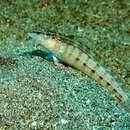Diagnostic Description
provided by Fishbase
This species is distinguished by the following characters: D V,21; A I,17; 14-16 (rarely 14 or 16) pectoral rays; 45-51 lateral-line scales; about 4 predorsal scales; ctenoid scales on cheek, in 5-6 horizontal rows; 3-4 + 8-10 gill rakers; front of lower jaw with 8 canine teeth; with palatine teeth; upper edge of subopercle with a prominent sharp spine; middle dorsal spine longest; membrane from last dorsal spine joined to base of first soft ray; body pale greenish to pale yellow dorsally, white below, with a series of 5 broad double dark bars on back, smaller posteriorly; lower part of body with a series of 9 bars, the top of each with a short blackish dash; a black line runs from the front of upper lip to eye, sometimes with 1-3 iridescent pale blue lines on snout and cheek below eye; 2 rows of black dots from behind eye along back to about middle of body, 1 row just above and the other just below lateral line; rear of cheek and lower opercle with black dots, often continuing in irregular rows anteriorly on body; first dorsal fin with a large dusky to dark brown spot at base, and often a submarginal dark brown or red line (or combined dark brown and red) (Ref. 57562).
- Recorder
- Estelita Emily Capuli
Morphology
provided by Fishbase
Dorsal spines (total): 5; Dorsal soft rays (total): 20 - 21; Analspines: 1; Analsoft rays: 16 - 18
- Recorder
- Estelita Emily Capuli
Trophic Strategy
provided by Fishbase
The species is generally found in calm environments on sand or rubble near reefs. Protogynous (Ref. 57562).
- Recorder
- Grace Tolentino Pablico
Biology
provided by Fishbase
The species is generally found in calm environments on sand or rubble near reefs. A protogynous hermaphrodite (Ref. 057562). Minimum depth of 3 m reported from Ref. 57562.
Parapercis lineopunctata: Brief Summary
provided by wikipedia EN
Parapercis lineopunctata, the nosestripe sandperch, is a fish species in the sandperch family, Pinguipedidae. It is found in the islands of Sumatra, Sulawesi, the Philippines, in Australia, on the Great Barrier Reef, the Solomon Islands and remote Lord Howe Island. This species reaches a length of 7.4 cm (2.9 in).
- license
- cc-by-sa-3.0
- copyright
- Wikipedia authors and editors

